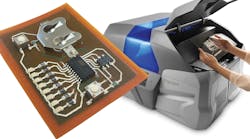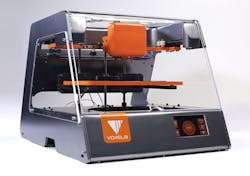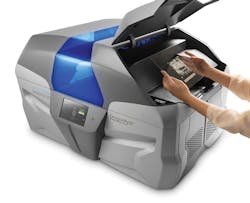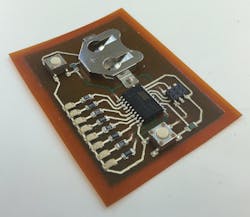Download this article in PDF format.
More companies and universities are integrating 3D printing with their electronic design. The non-traditional process was well-received as it moved from the aerospace to automotive to medical industries. Electronics could be next on the list to benefit from 3D printing, according to Ernst and Young. Today, many people say we will never 3D-print phones and other complex, multi-material products. However, with so many companies pushing to develop a magical all-encompassing printer, will we see electronics being manufactured with 3D printing?
Voxel8 plans to sell its current printer (pictured here) for research. However, over the next couple years, this printer will provide the information needed to redesign another for industrial applications.
Generally no, but the exciting thing is that we are even conceiving of 3D printing a complex circuit with multiple materials that might someday produce a fully 3D-printed electronic device. While 3D printing might not be how electronics devices are manufactured, for now it’s a way PCB designers can reduce their prototyping times. In fact, in a study done by Ernst and Young 3D printing electronics helped lower prototyping time by an average of 63%.
PCB Prototyping New vs. Old
Problems surrounding traditional methods of prototyping PCBs include the fact that it can take weeks for PCBs to be delivered. Sometimes they’re ordered from other countries because it is more cost-effective. In fact, most of the world’s PCBs are manufactured in East Asia—in 2012, China handled about 40% of the PCB market, according to Prismark Partners LLC.
Testing is another prototyping issue. PCB prototyping often only requires one of a few boards to test. However, many PCB fabricators require a minimum quantity that far exceeds what is needed,
Both of the above can be alleviated with 3D printing.
Nano Dimension is on the forefront of this technology, and just successfully completed its beta program of the Dragonfly2020 Pro. This larger, more robust version of the already-available desktop DragonFly2020. The Dragonfly Pro is now moving into early access commercial sales.
The Nano Dimension Dragonfly 2020 is capable of printing advanced multi-layer PCBs on multiple substrates, which means you can have rigid or flexible circuits.
One of the first adopters of Nano Dimension’s Dragonfly 2020 is PHYTEC. “We outsource PCB designs. Simple to medium complex boards can have a lead time of eight working days. But it is easy to see lead times up to 50 days for our more complex designs,” says PHYTEC’s CTO Bodo Huber. “There is a one-time setup cost of anywhere from $200 to about $600 dollars that can easily double with express fees.
“Printing prototypes in-house is easily 10 to 15 times faster than outsourcing. In addition, we improve our quality because we have faster design validation that lets us have more frequent redesigns. It often takes four to five iterations for a new hardware design, and often you have just two to three weeks per iteration.”
You have to operate on the edge of a knife when lead times are one to six weeks, and your schedule between iterations is two to three weeks. Huber also mentioned he believes 3D printing of end-use PCBs, in small volume, could be possible as the technology matures.
Supply Chain
More companies will adopt 3D printing as it matures as a way to improve PCB prototyping. 3D printing in-house could lead to significant reduction in materials, labor, inventory, distribution, and more. It also has the potential to simplify or completely eliminate other services such as warehousing and aftermarket services. Ultimately, the increased adoption of the technology will disrupt the electronics supply chain. Investors will no doubt keep an eye on this development, especially when prototyping costs begin to drop and thus drive down the cost of embedded devices.
A whitepaper sponsored by tti and TE describes how 3D printing may change the electronic supply chain: “The upstream supply chain can be shortened and simplified as raw materials are substituted for semi-fabricated products. Procurement expenses can be lowered as embedded labor costs are shed from manufacturing inputs.”
A 3D-printed circuit will be popular with wearable technology. Circuits with batteries, and anything necessary, are able to be printed on self-adhering films that can be printed, peeled, and applied directly to the skin. The substrate and connecting paths in this circuit are 3D-printed. The electronic components are picked and placed by the same machine from BotFactory.
Already, 3D printing is disrupting many other technologies and supply chains. In manufacturing, it can eliminate the need for tooling and molds, or print them faster than traditional processes. 3D printing also expands customization or personalized capabilities. Printing multiple parts as a single piece eliminates assembly labor and time. Consolidation isn’t lost on 3D printing electronics either—the manufacturing steps of film deposition, lithography, and etching can be merged into a single step.
As technology progresses, we see the trends of labor reduction and streamlining production coming to bear. As touched on above, it will reduce the amount of steps from manufacturer to customer. It’s important to note that this technology was only mentioned as a prototyping method. As 3D printing matures, low-volume production could very well enter the picture, too.
Traditional processes are still alive and well, and will be for the foreseeable future. However, early adopters of 3D-printing technology will have a competitive advantage. As this technology advances, it will start to disrupt—but not totally replace—traditional processes.
Future Possibilities
Early adopters paying attention to these advances will understand how best to use the technology. While new uses for inks and pastes are quickly being developed to augment the PCB and sensor markets, filaments are certainly not being left behind.
Recently, the Pratt School of Engineering at Duke University published “3-D Printers Open New Design Space for Wireless Devices.” The report details how the school was able to print an electromagnetic metamaterial using an electrically conductive material that’s printable in a standard fused-filament-fabrication (FFF) printer. This approach would save lots of money compared to using a metal printer, such as a powder bed, which often cost hundreds of thousands of dollars.
An illustration of how 3D-printed metamaterial unit cells could be combined like Lego blocks to create structures that bend or focus microwave radiation more powerfully than any material found in nature. It takes about 20 minutes to 3D-print one metamaterial unit cell using the Electrifi filament and a relatively low-cost 3D printer. By combining a series of these cells, each tailored to interact with an electromagnetic wave in a certain way, researchers are able to create a structure that can powerfully manipulate microwave radiation.
Filaments in general are not as conductive as inks. Yet Benjamin Wiley, Duke’s associate professor of chemistry and Shengrong Ye, a postdoctoral researcher in Wiley’s group, created a 3D-printable material that is 100 times more conductive than the previous conductive filament Black Magic 3D. Black Magic 3D has a volume resistivity of 0.6 ohm-cm. The new material, Electrifi Conductive 3D, measures 0.006 ohms-cm. Electrifi Filament is a proprietary metal-polymer composite that consists primarily of a biodegradable polyester and copper.
This may not seem like a big step, as the resistivity of copper is 1.68 x 10−5 ohm-cm. Yet Steve Cummer, professor of electrical and computer engineering at Duke, thought that it might be conductive enough to create a 3D-printed electromagnetic metamaterial (a synthetic composite of materials that are not found in nature). After testing, the 3D-printed material interacted with the electromagnetic waves 14 times better than its 2D counterpart.
The companies able to adopt and design creative solutions that take advantage of 3D-printing technology will expand not only 3D-printing capabilities, but also what their electronics can do and how much better they can perform. In time, 3D printing of electronics may follow the same path we have seen in the automotive and aerospace industries. As new engineers come through the school system and learn this technology, we may really see a jump in design as they enter the field.













